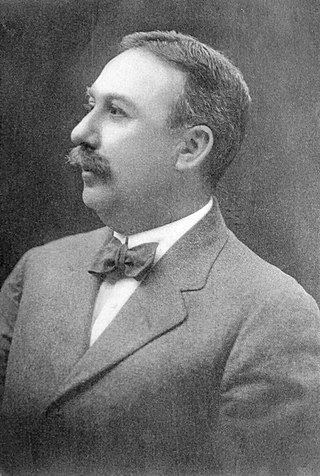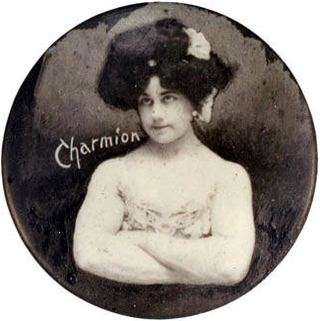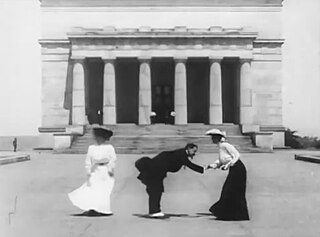
The Great Train Robbery is a 1903 American silent film made by Edwin S. Porter for the Edison Manufacturing Company. It follows a gang of outlaws who hold up and rob a steam locomotive at a station in the American West, flee across mountainous terrain, and are finally defeated by a posse of locals. The short film draws on many sources, including a robust existing tradition of Western films, recent European innovations in film technique, the play of the same name by Scott Marble, the popularity of train-themed films, and possibly real-life incidents involving outlaws such as Butch Cassidy.

Edwin Stanton Porter was an American film pioneer, most famous as a producer, director, studio manager and cinematographer with the Edison Manufacturing Company and the Famous Players Film Company. Of over 250 films created by Porter, his most important include What Happened on Twenty-third Street, New York City (1901), Jack and the Beanstalk (1902), Life of an American Fireman (1903), The Great Train Robbery (1903), The European Rest Cure (1904), The Kleptomaniac (1905), Life of a Cowboy (1906), Rescued from an Eagle's Nest (1908), and The Prisoner of Zenda (1913).

Life of an American Fireman is a short, silent film Edwin S. Porter made for the Edison Manufacturing Company. It was shot late in 1902 and distributed early in 1903. One of the earliest American narrative films, it depicts the rescue of a woman and child from a burning building. It bears notable similarities to the 1901 British short film Fire!, directed by James Williamson.

Laverie Vallee, best known by her stage name Charmion, was an American vaudeville trapeze artist and strongwoman. One of her risqué trapeze acts was captured on film in 1901 by Thomas Edison.

Another Job for the Undertaker is a 1901 silent comic trick film made at Edison's recently opened studio at 41 East 21st Street in Manhattan. It was photographed by Edwin S. Porter and co-directed by Porter and George S. Fleming. The two-shot film was copyrighted on May 15, 1901 and is approximately two minutes in length. It lacks a head title, which would have been supplied by projecting a separate lantern slide before screening the film.

What Happened on Twenty-third Street, New York City is a 1901 American short film starring A. C. Abadie and Florence Georgie in which a woman's undergarments are accidentally exposed. A similar 1901 film, Soubrette's Troubles on a Fifth Avenue Stage, also starred Abadie and Georgie.

The Martyred Presidents is a 1901 American film directed by Edwin S. Porter.
Charles John Musser is a film historian, documentary filmmaker, and a film editor. Since 1992, he has taught at Yale University, where he is currently a professor of Film and Media Studies as well as American Studies and Theater Studies. His research has primarily focused on early cinema, and topics such as Edwin S. Porter, Oscar Micheaux, race cinema of the silent era, Paul Robeson, film performance, as well as a variety of issues and individuals in documentary. His films include An American Potter (1976), Before the Nickelodeon: The Early Cinema of Edwin S. Porter (1982) and Errol Morris: A Lightning Sketch (2014).

Jack and the Beanstalk is a 1902 American silent trick film directed by George S. Fleming and Edwin S. Porter. With ten sequential shots, Jack and the Beanstalk was twice as long as any previous studio film. According to Porter, "It took in the neighborhood of six weeks in the spring of 1902 to successfully make this photograph."
George S. Fleming was an American actor, director, and scenic designer whose short films were influential early projects in the medium.

Execution of Czolgosz with Panorama of Auburn Prison is a 1901 silent film produced by the Edison Studios arms of Edison Manufacturing Company. The film is a dramatic reenactment of the execution of Leon Czolgosz by electric chair at Auburn Correctional Facility following his 1901 conviction for the assassination of William McKinley. It is considered an important film in the history of cinema.
By the Light of the Moon is a 1911 American single-reel silent film directed and filmed by Edwin S. Porter. It was produced for the Rex Motion Picture Company. It is one of the earliest examples of silhouette animation.

Kansas Saloon Smashers is a 1901 comedy short film produced and distributed by Edison Studios. Directed by Edwin S. Porter, it is a satire of American activist Carrie Nation. The film portrays Nation and her followers entering and destroying a saloon. After the bartender retaliates by spraying Nation with water, policemen order them out; the identities of the actors are not known. Inspiration for the film was provided by an editorial cartoon which appeared in the New York Evening Journal.

Rube and Mandy at Coney Island was produced, directed, shot and edited by Edwin S. Porter Copyrighted on August 13, 1903, the 725 ft., 35mm film lasted roughly 10 minutes if projected at 20 frames per second.
Gilbert Saroni, also written Gilbert Sarony, was a cross-dressing performer in vaudeville as well as early Edison Manufacturing, American Mutoscope, and Siegmund Lubin films. In his obituary in Variety he was described as one of the first impersonators of the "old maid" type and was said to be "considered one of the funniest men in the show business."

The Whole Dam Family and the Dam Dog is a 1905 silent short comedy film directed by Edwin S. Porter for the Edison Manufacturing Company. The five-and-a-half minute film was an adaptation of a popular picture postcard featuring a humorously named family. The film introduces each member of the Dam family, and then shows a raucous dinner scene that ends with the Dam dog pulling the tablecloth off the table, and ruining the Dam meal.

Laura Comstock's Bag-Punching Dog is a 1901 silent short film directed by Edwin S. Porter. The film depicts a vaudeville act featuring Laura Comstock and her trained dog, a pit bull named Mannie. Comstock's act was currently appearing at Keith's Union Square Theatre.

The Gay Shoe Clerk is a 1903 silent short film directed by Edwin S. Porter. The film depicts a risqué comic encounter between a clerk and his female customer while she is trying on shoes.

How a French Nobleman Got a Wife Through the New York Herald Personal Columns is a 1904 silent comic film directed by Edwin S. Porter for the Edison Manufacturing Company. The film is a remake of the hit film Personal, produced by the Biograph Company earlier in the year. The film is a spoof of the "fashionable marriages" known to take place between cash-strapped European nobility and American heiresses.

Why Mr. Nation Wants a Divorce is a 1901 silent short comedy film directed by Edwin S. Porter and George S. Fleming. It is a satire on the activities of radical temperance advocate Carrie Nation, who was known for her crusade against bars and taverns. Earlier in 1901, Porter directed another film mocking Nation, Kansas Saloon Smashers; this follow-up film was inspired by news reports that Nation's husband demanded a divorce.
















